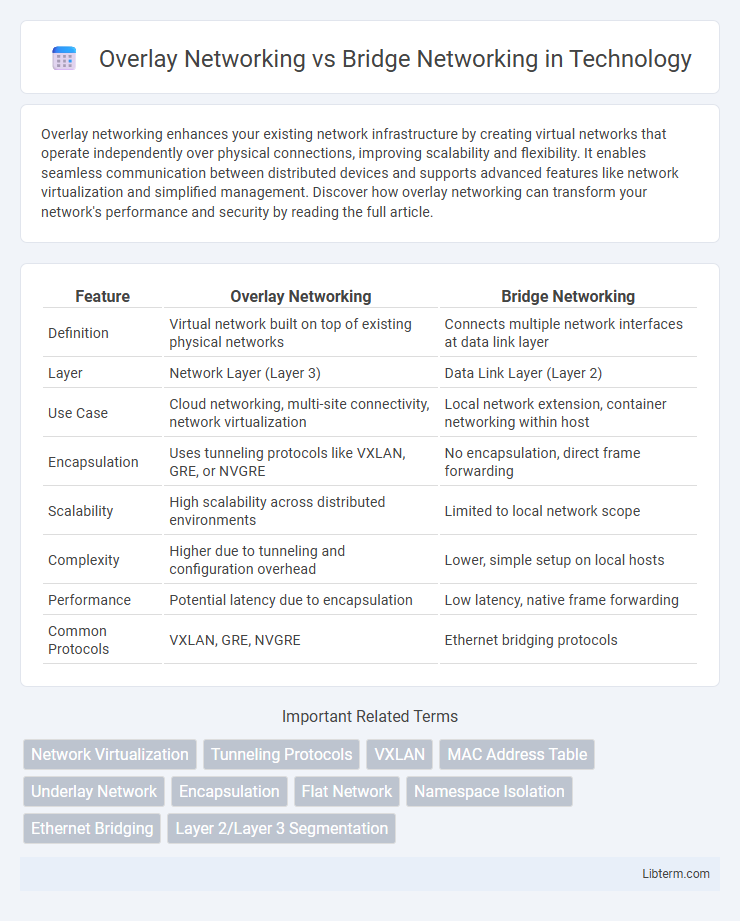Overlay networking enhances your existing network infrastructure by creating virtual networks that operate independently over physical connections, improving scalability and flexibility. It enables seamless communication between distributed devices and supports advanced features like network virtualization and simplified management. Discover how overlay networking can transform your network's performance and security by reading the full article.
Table of Comparison
| Feature | Overlay Networking | Bridge Networking |
|---|---|---|
| Definition | Virtual network built on top of existing physical networks | Connects multiple network interfaces at data link layer |
| Layer | Network Layer (Layer 3) | Data Link Layer (Layer 2) |
| Use Case | Cloud networking, multi-site connectivity, network virtualization | Local network extension, container networking within host |
| Encapsulation | Uses tunneling protocols like VXLAN, GRE, or NVGRE | No encapsulation, direct frame forwarding |
| Scalability | High scalability across distributed environments | Limited to local network scope |
| Complexity | Higher due to tunneling and configuration overhead | Lower, simple setup on local hosts |
| Performance | Potential latency due to encapsulation | Low latency, native frame forwarding |
| Common Protocols | VXLAN, GRE, NVGRE | Ethernet bridging protocols |
Introduction to Overlay and Bridge Networking
Overlay networking creates virtual networks on top of existing physical networks, enabling seamless connectivity across geographically dispersed nodes by encapsulating packets within tunneling protocols such as VXLAN or GRE. Bridge networking connects multiple network interfaces at the data link layer (Layer 2), allowing devices on separate physical networks to communicate as if they were on the same local network segment. Overlay networking is essential for scalable cloud environments and multi-tenant infrastructures, while bridge networking is typically used in simpler, local area network setups.
Core Concepts: What is Overlay Networking?
Overlay networking creates virtual networks on top of existing physical networks, enabling seamless connectivity between distributed environments without altering underlying infrastructure. It uses encapsulation techniques like VXLAN or GRE tunnels to isolate traffic and extend Layer 2 networks over Layer 3 boundaries. This approach enhances scalability, flexibility, and segmentation in cloud and data center environments compared to traditional bridge networking.
Core Concepts: What is Bridge Networking?
Bridge networking creates a network bridge that connects multiple network segments at the data link layer (Layer 2), allowing devices to communicate as if on the same physical network. It operates by forwarding Ethernet frames between interfaces, enabling seamless communication and reducing network traffic by filtering and forwarding packets selectively. Bridge networking is commonly used in container environments to allow containers on the same host to communicate through a virtual bridge.
Architecture Comparison: Overlay vs Bridge Networks
Overlay networking architecture relies on encapsulating packets within tunnels to create virtual networks over physical infrastructure, providing scalability and isolation across multiple hosts. Bridge networking connects virtual interfaces to a local Ethernet bridge, enabling direct communication within the same physical network segment but limiting scalability beyond a single host. Overlay networks utilize protocols like VXLAN or GRE for encapsulation, while bridge networks use traditional Layer 2 bridging to forward traffic between containers or VMs on the same host.
Use Cases for Overlay Networking
Overlay networking excels in multi-site cloud environments by enabling secure connectivity across dispersed data centers and public clouds without requiring physical network changes. It supports container orchestration platforms like Kubernetes, facilitating dynamic, scalable communication between microservices in distributed applications. This approach is ideal for hybrid cloud deployments and multi-tenant SaaS products, where network isolation and seamless traffic routing across complex infrastructure are critical.
Use Cases for Bridge Networking
Bridge networking is ideal for container environments requiring seamless communication between containers on the same host, enabling low-latency and high-throughput data exchange. It excels in development and testing scenarios where isolated network segments simulate production environments without complex configuration. Use cases also include legacy applications that depend on a flat Layer 2 network topology with straightforward IP address management.
Performance and Scalability Considerations
Overlay networking leverages encapsulation techniques such as VXLAN or GRE to create virtual networks over existing physical infrastructure, which may introduce additional latency and CPU overhead affecting performance. Bridge networking, relying on Layer 2 connections, typically offers lower latency and better throughput by directly forwarding packets within the same broadcast domain but lacks the scalability for large multi-host environments. Scaling overlay networks is more efficient across geographically dispersed data centers or cloud environments, while bridge networking is limited to smaller, local or single-host network segments.
Security Implications of Both Networking Models
Overlay networking encrypts traffic between nodes, enhancing security by isolating data within virtual networks across public infrastructure, reducing exposure to external threats. Bridge networking relies on direct layer 2 connectivity, increasing vulnerability to attacks such as ARP spoofing and network sniffing due to shared broadcast domains. The choice between overlay and bridge networking significantly impacts network segmentation, data confidentiality, and resistance to lateral movement by attackers.
Integration with Cloud and Container Environments
Overlay networking enables seamless integration with cloud and container environments by encapsulating VM or container traffic across different physical networks, supporting multi-tenant isolation and dynamic scaling typical of Kubernetes and Docker Swarm. Bridge networking operates at Layer 2, allowing containers to communicate within the same host or local network segment, providing low-latency connectivity but limited scalability in distributed cloud settings. Overlay networks enhance cross-host container communication and simplify network management in hybrid and multi-cloud deployments, making them ideal for complex container orchestration platforms.
Choosing the Right Networking Model for Your Needs
Overlay networking offers increased scalability and enhanced isolation by encapsulating traffic between virtual networks, making it ideal for multi-tenant environments and complex cloud infrastructures. Bridge networking provides straightforward connectivity by linking containers or virtual machines directly within the same host or network segment, which is sufficient for simple, low-latency communication scenarios. Selecting the right model depends on factors like network scale, isolation requirements, and performance needs, with overlay networks suited for dynamic, large-scale distributed systems, while bridge networks excel in smaller, more controlled environments.
Overlay Networking Infographic

 libterm.com
libterm.com